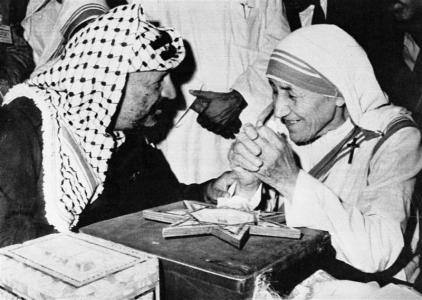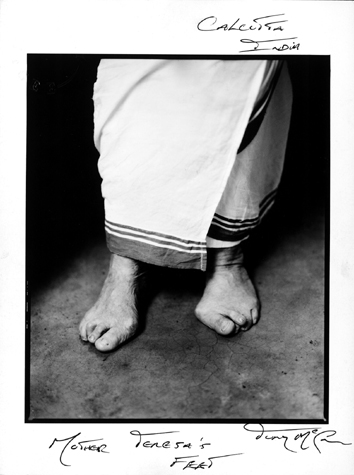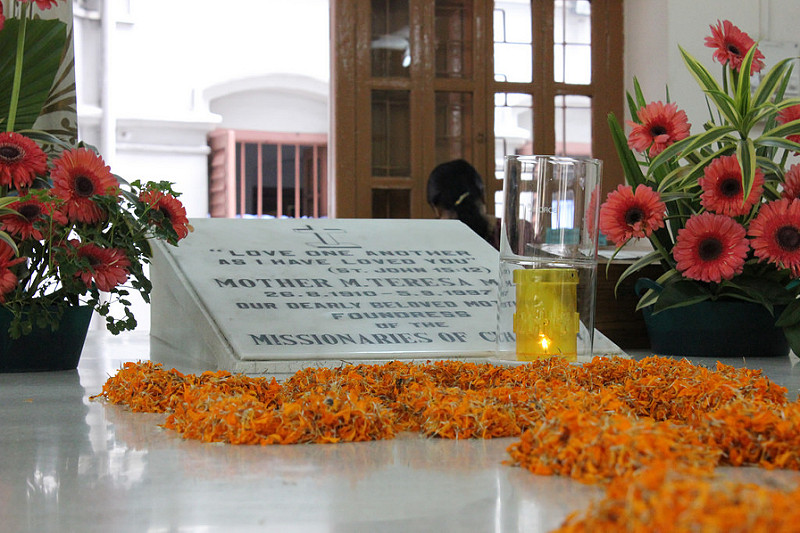The making of a saint
Mother Teresa was born in 1910 in the Albanian provinces of the Ottoman Empire and baptized Gonxha Agnes Bojaxhiu. Her mother Nikola had a strong influence in shaping her personality. After Agnes’ politically influential merchant father died suddenly, what was a financially sound family was suddenly left in poverty. However, her mother Nikola still continued helping the poor, and encouraged Agnes to do the same. Nikola often said, “When you do good, do it quietly -as if you were throwing a stone into the sea.” This lesson remained with young Agnes, who would later become an icon of generosity and charity.
She joined an Irish convent at the age of 18, and became known by the name Sister Mary Teresa. A few months later around January 1929, she arrived in the city of Calcutta, then known as Kolkata. She began teaching at St. Mary’s School for girls, where she also served as headmistress. On 10 September 1946 during the train ride from Calcutta to Darjeeling for her annual retreat, she saw abject poverty around her in a complete different light, and received her inspiration to do something to improve the lives of the poor.
Launching the Missionaries of Charity
In 1948, for the first time, she wore the symbolic blue–lined white cotton sari, and launched the Missionaries of Charity to serve the poor. In 1979, she was awarded the Nobel Peace Prize for her selfless work to uplift the poor and her efforts to bring an end to the suffering caused by sickness and poverty.
In order to be accepted by the poor for whom she wanted to work, Mother Teresa decided to live a life of poverty herself. When she began her mission, she was joined by two young dedicated nuns, one of whom was studying to become a doctor. They wore simple white cotton saris with the iconic blue border. In her diary, Mother Teresa wrote, “In our convent we are so very happy. Silence is beautifully observed. The young postulants are so fervent that I am forced to follow them. The poverty which seemed so clear in the plan is actually taking form.”
The best proof of this would be Mother Teresa’s feet which over time became deformed and knobby. Mother Teresa and her sisters would depend on donations for all their needs, including their footwear. When any such donated shoes would come in, Mother Teresa would always choose the worst pair of shoes for herself. Because of such ill-fitting shoes, Mother Teresa’s feet eventually got damaged over time.
Opinion on generosity and giving to others
Though Mother Teresa’s life and work was considered to be the epitome of generosity, she herself believed that poverty-stricken people had the most generous hearts. She recounts inspiring experiences which she had, where persons who themselves were struggling for food, shared their possessions with others whom they thought needed it more. In her own words, Mother Teresa said,
“I will tell you a story. One night a man came to our house and told me, “There is a family with eight children. They have not eaten for days.” I took some food with me and went. When I came to that family, I saw the faces of those little children disfigured by hunger. There was no sorrow or sadness in their faces, just the deep pain of hunger. I gave rice to the mother. She divided the rice in two, and went out, carrying half the rice. When she came back, I asked her, “Where did you go?” She gave me this simple answer, “To my neighbors; they are hungry also!” I was not surprised that she gave – poor people are really very generous. I was surprised that she knew they were hungry. As a rule, when we are suffering, we are so focused on ourselves; we have no time for others.”
Why her critics are wrong
Some people have accused Mother Teresa of accepting large amounts of money and funds as donation from various powerful figures, even mingling with influential politicians and businessmen who were accused of objectionable activities. However, why should it be assumed that people who are politically controversial should not be allowed to offer support to orphans, the sick and suffering? For example, Mother Teresa’s integrity was brought under question, when Palestine Liberation Organization leader Yasser Arafat insisted on meeting her while on his visit to India in 1990. Mother Teresa, who was a spiritual person, probably knew that it would be hypocrisy if she propagated the idea of universal love and peace – but then acted in a judgemental way against Arafat. Being a compassionate woman by nature, she accepted Arafat’s request.

Arafat with Mother Teresa during his visit to India on March 28, 1990. Source: Nisar Ahmed Channa/flickr
Contrary to critics’ claims that she willingly accepted funds from controversial people, Mother Teresa did so only for the benefit of the poor people she served. Explaining what the true spirit of generosity and charity meant, she elaborated, “Have you ever experienced the joy of giving? I do not want you to give to me from your abundance. I never allow people to have fundraisers for me. I don’t want that. I want you to give of yourself. The love you put into the giving is the most important thing. I don’t want people donating just to get rid of something. There are people in Calcutta who have so much money that they want to get rid of it. They sometimes have money to spare, money that they try to hide.”
She shared an incident which disturbed her, “A few days ago I received a package wrapped in plain paper. I thought that it might contain stamps, cards, or something like that, so I put it aside. I planned to open it later when I had the time. A few hours later I opened it without even suspecting its contents. It was hard for me to believe my eyes. That package contained twenty thousand rupees. It didn’t have a return address or any note, which made me think that it might be money owed to the government. I don’t like people to send me something because they want to get rid of it. Giving is something different. It is sharing. I also don’t want you to give me what you have left over. I want you to give from your want until you really feel it!” Here, Mother Teresa clearly explains her ideology in accepting charity and donations from others – as long as someone wishes well and genuinely wants to share with others, and then nothing else should matter. She explains this best with this small account of a paralysed man, “I received $15 from a man who has been paralyzed for 20 years. The paralysis only allows him the use of his right hand. The only company he tolerates is tobacco. He told me, “I have stopped smoking for a week. I’m sending you the money I’ve saved from not buying cigarettes.” It must have been a horrible sacrifice for him. I bought bread with his money, and gave it to those who were hungry. So both the giver and those who received experienced joy.”
Commitment to the cause of uplifting the poor
Her commitment to her mission was ardent, and she even encouraged the young nuns under Missionaries of Charity to keep their focus only on their noble mission – to be Christ-like and to see Christ in every person. The third woman to join the Missionaries of Charity, Sr Gertrude completed her MBBS from Calcutta University and was awarded a gold medal for her academic brilliance. As she was thrilled to share this news, Mother Teresa said to her, “you don’t need a gold medal to serve Jesus and the poor. Return it. Someone else could benefit it more than you.” Sr Gertrude then returned the medal. Such was their commitment to their cause.
Sainthood well-deserved
Pope Francis announced that Mother Teresa would be canonized as a saint on 4 September this year. She was earlier beatified in October 2003 by now deceased Pope John Paul II, after which she was known as Blessed Mother Teresa.
The decision to elevated Blessed Mother Teresa to sainthood was taken after a second miracle was witnessed through her intervention, when a Brazilian man was medically proven as cured of multiple brain tumours just by the prayers offered to her by the man’s family and loved ones. The first miracle was when a 30-year-old woman revealed that she was cured of a stomach tumour after praying to Mother Teresa. As the investigations conducted by the Vatican could not determine any scientific reason for this cure, it was declared as a miracle.
Presently, Mother Teresa’s tomb rests in the Missionaries of Charity’s Kolkata centre, and the mission has spread across charity centres worldwide – including Africa, North America, Europe and Australia.
Blessed Mother Teresa will soon be known as Saint Mother Teresa, and has taught mankind many wonderful things about reaching out to fellow human beings.






